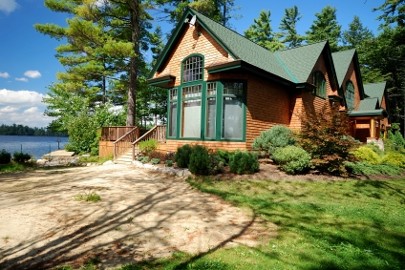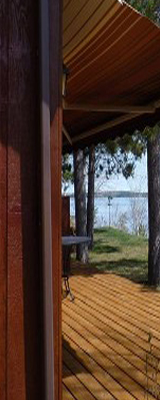All in the Family: Cabin Crisis

A cabin can be a breeding ground for a family feud. It’s important to plan how to pass it down through generations.
original article published in the Minnesota Star Tribune by KARA MCGUIRE
http://www.startribune.com/lifestyle/yourmoney/55459457.html
Bea Anderson and her siblings have always made decisions about their shared cabin with a handshake. With just a brother and a sister and their spouses to consult, that hasn’t so hard. But the cabin on Lake Vermillion, which has been in the family for more than 50 years, will pass to seven families in the next generation. “When there’s more people involved, then you get more opinions. We wanted to set up guidelines about how we feel the cabin can be run successfully,” Bea’s husband, Jerry Anderson, said. They needed a plan and turned to a cabin trust. Without a trust, cabins are often passed to the next generation in equal shares, with equal responsibility for the expenses and upkeep. That arrangement is known as tenants-in-common. No problem, right?
But what if the new generation of owners can’t devise a schedule for using the cabin? What if they can’t make decisions about whether to put on a new roof or add a garage? What happens if someone wants to sell his share of the cabin? In the event of a divorce or death, does the unrelated spouse get an interest, so a share of the cabin is now owned outside of the family? And if one owner can’t afford his share and ultimately files for bankruptcy, then what?
“The solutions to those [issues], if you don’t have some mechanism to deal with them, is a court proceeding. And as you can imagine, kids don’t get long so well after you serve them papers,” said Joel Mullen, a Bloomington attorney who specializes in cabin trusts. A trust lays out how a cabin is to be owned, cared for, paid for and used once the current owners pass away. It also addresses who will be the trustee. Typically, one or more of the children are selected, but sometimes a neutral third party, such as a bank without an interest in the cabin, is selected. To get some additional information you should read this.
In the case of Bea’s family cabin, the current owners gave the future owners some time to think about whether they wanted to own art of the cabin. Jerry Anderson wasn’t surprised when everyone said they wanted in. The cabin is built on land Bea’s father, who was a miner in Soudan, Minn., bought from the mining company. “It is really special,” he said. In the event that someone says “no thanks,” families typically use other assets from the estate to buy that person’s share of the cabin.
Family wishes
Working with St. Paul attorney Frank Heers, the family created a rotation to ensure one family doesn’t get all the good holidays. They also came up with rules about how to spend money to maintain the property. Large projects that would cost thousands, like putting on a new roof or building an addition, for example, require 100 percent agreement, while with most smaller projects, the majority rules.
Most important, they agreed upon rules outlining one of the most contentious cabin issues: What happens if one family wants to sell its share? Attorneys recommend that after determining fair market value, the family wanting out sells its share to the other owners at a discount.
Without [the discount], it doesn’t really give a financial incentive to your brother or sister to buy you out. So we create that,” Mullen said. Payments could be spread out over several years so the sale wouldn’t strain the remaining owners’ finances. In addition to a cabin trust, cabin owners might also consider a limited liability corporation or limited liability partnership. Heers uses an LLC when someone out of state owns an interest in a Minnesota cabin.
He also considers it if multiple families own a cabin or the property is being rented out. LLCs can do a better job to limit the liability of the cabin owners in the event that a visitor is injured at the property and then sues. LLCs can also last forever. If those options seem like overkill, tenants-in-common should at least create a tenancy agreement, which Heers describes as “a contract between co-tenants to use the property a certain way.”
But he doesn’t create many tenancy agreements because major ownership issues, such as what happens to the property in the event of a divorce or bankruptcy, aren’t easily addressed. Ideally, estate planning attorneys say that a cabin trust would go hand-in-hand with the rest of an estate plan, especially if estate taxes are an issue.
According to the attorneys I spoke with, a cabin trust or LLC will cost you anywhere from $1,500 to $4,000. Some attorneys who usually work on a flat-fee basis may charge by the hour because creating a cabin estate plan can be messy. But the expense and hassle are likely cheaper than a mediation between several owners who have no rules to abide by and can’t come to an agreement. A tenants-in-common agreement should cost less than $1,000.
Whether a family goes with a tenants-incommon agreement, a cabin trust or an LLC, there is one advantage that comes with all of the options: Families discuss their wishes. Sometimes, the current owners just assume the younger generation wants to keep the cabin in the family when, in fact, the kids can’t wait to sell it. Other times, parents assume children who grumble about making it to the family lake house will want to unload it.
But the children have visions of spending lazy summers fishing with their kids. “Having that honest conversation really helps,” Mullen said. Easier said than done, right? Here are resources to consider. Peter McClellan had many clients who insisted their kids wouldn’t fight when they died. “Then they pass away and it’s World War III,” said McClellan, president of the 401k Latte Co. in Lakeville. So he compiled a book of inheritance stories called “Cabinosity” with the hopes that it would get families to start talking before it’s too late.
Another resource that deals with inheritance without squabbles is the University of Minnesota Extension Service’s “Who Gets Grandma’s Yellow Pie Plate?” A lot of that material is available at www.yellowpieplate.umn.edu.
Kara McGuire, Minneapolis Star Tribune • 612-673-7293.

